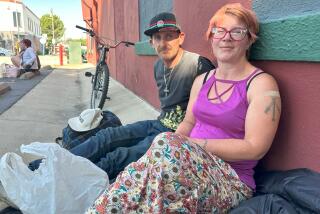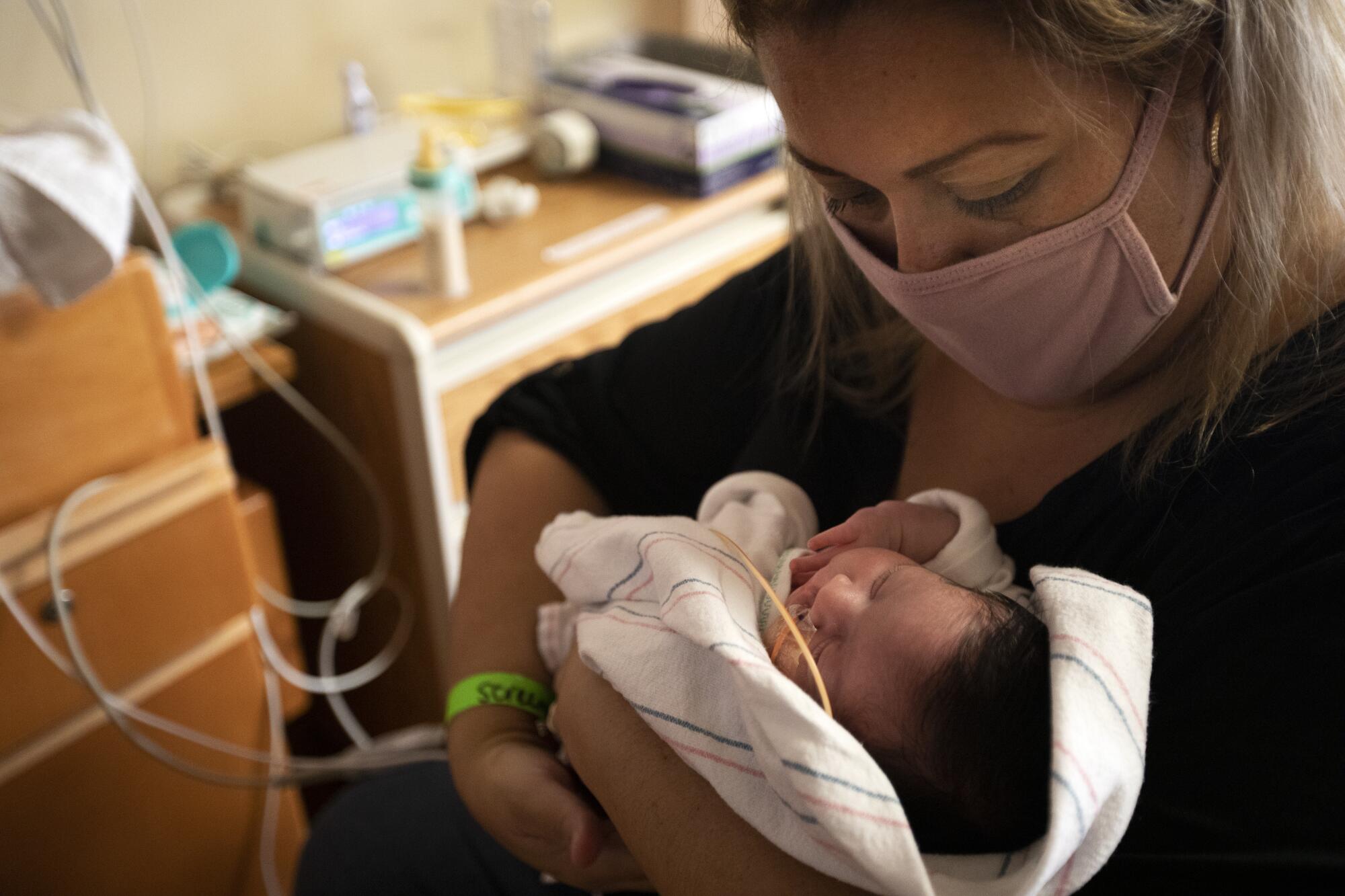
The last thing Monica Ramirez remembers is hearing her doctor’s voice.
“You have COVID, honey,” he said. “But you’re going to be OK.”
She had driven herself to the emergency room at Corona Regional Medical Center on a blistering afternoon in July. She was 38 years old, 30 weeks pregnant, and she could not breathe.
Ramirez woke up from a medically induced coma nearly three weeks later. In a different city. In a different hospital. Hooked up to a ventilator. The room was dark. Her first thought? That she had somehow ended up in a dungeon. And then she heard laughter.
“All the doctors and nurses were clapping and high-fiving,” she said. “They were asking my nurse for the day, ‘Where’s her baby? How’s her baby?’
“But I didn’t know what baby they were talking about, because I was still pregnant.”

The jubilation in the intensive care unit at Loma Linda University Medical Center that day stemmed from a simple fact: Ramirez had regained consciousness. Fourteen days earlier, doctors had delivered her baby by emergency caesarean section.
Emiliana was born July 13 — 10 weeks early, weighing 3 pounds, 6 ounces. She needed a ventilator for the first several days of her life. More than a month would pass before she felt her mother’s touch. She spent her first eight weeks in the neonatal intensive care unit.
The day Ramirez delivered Emiliana, the new mom was one of 19,502 people in hard-hit San Bernardino County who had contracted COVID-19. (The county has now reported more than 61,000). She was one of 616 confirmed cases in a hospital there and one of 174 in a San Bernardino County intensive care unit.
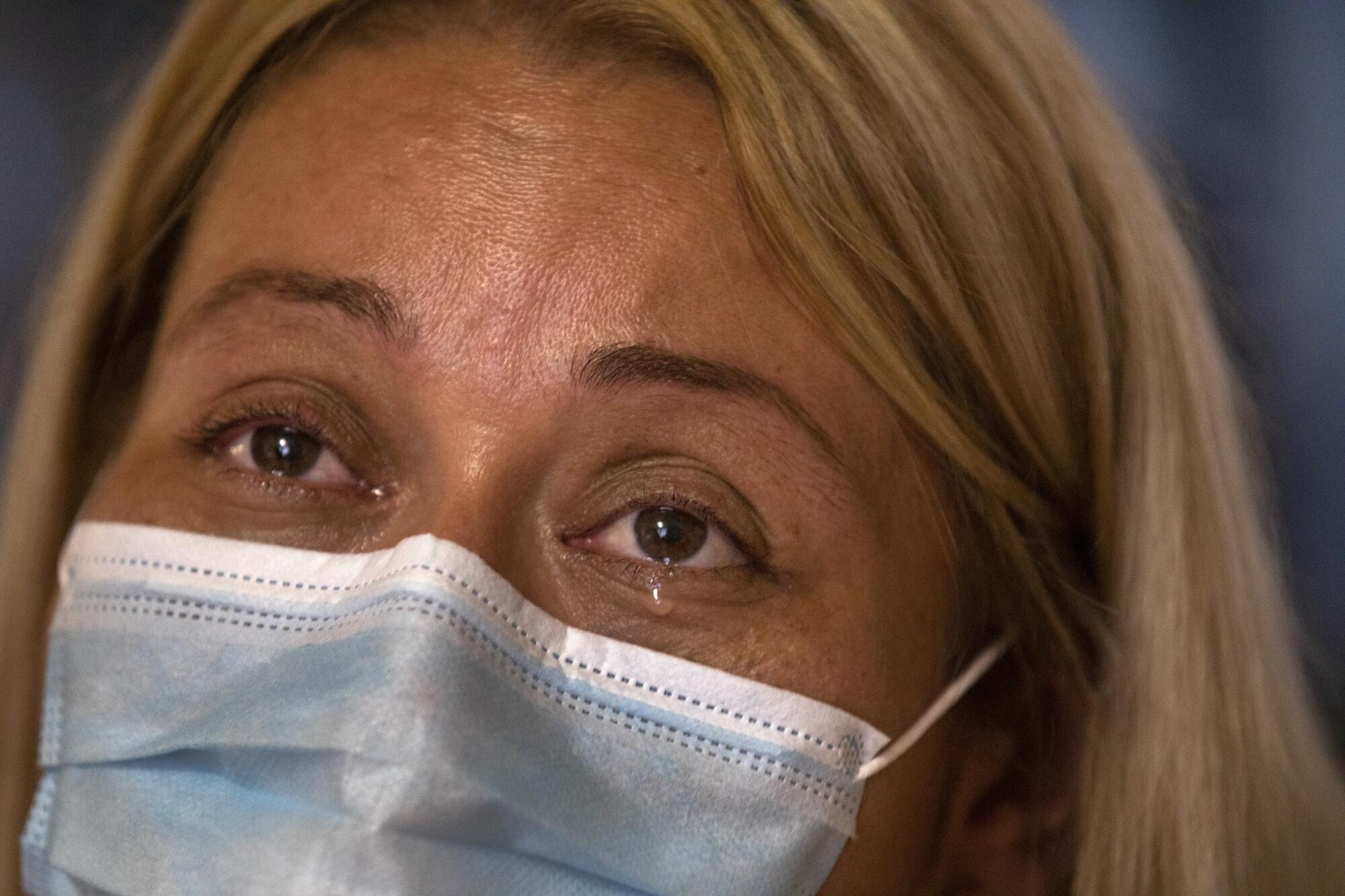
Of the 48 pregnant women who have been admitted to Loma Linda University Medical Center with COVID-19, 45 are Latina — an extreme snapshot of a disease that has infected and killed Latinos at a rate disproportionate to their share of the population.
Very little is known about the impact of COVID-19 on women and the babies they carry. It is still not clear how a pregnant woman passes the virus on in the rare cases in which a baby has become infected. Most of the early research on COVID-19 has used data from older men, because they have gotten sickest and died in greater numbers.
“What’s unique about COVID-19 is we haven’t really been able to identify out of the gate why some moms seem not sick at all,” said Dr. Courtney Martin, medical director for maternity services at Loma Linda University Children’s Hospital. “And then another portion are insanely sick, like Monica. Who almost died. Several times.”
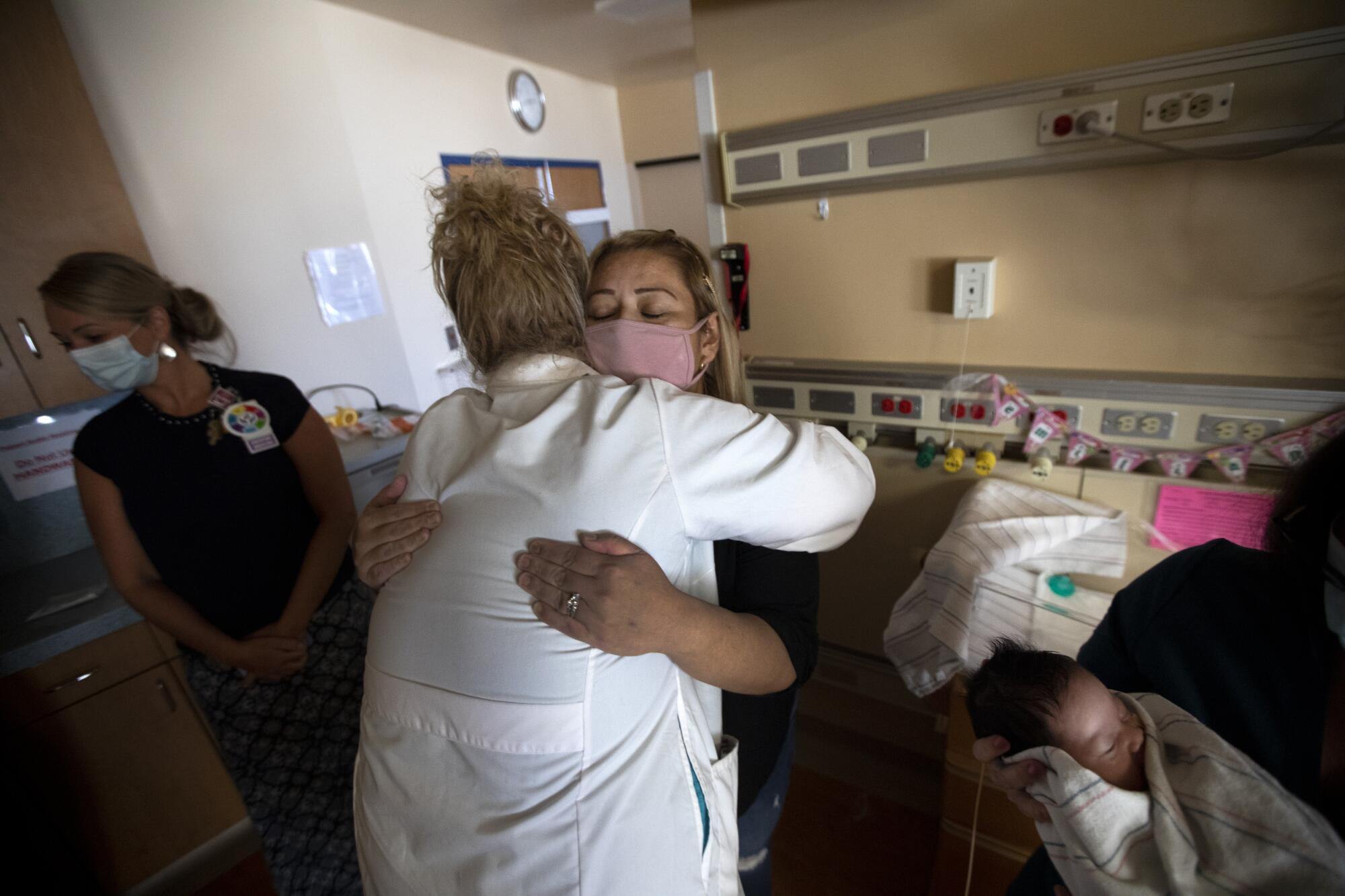
::
Ramirez was dragging on the Fourth of July, when she gathered with her family at their Corona home for a barbecue. Her husband, Juan, grilled hamburgers and hot links. Fireworks were planned for later that night.
Her 11-year-old daughter, Viviana, was there, and so was her mother, Hermila Nuñez, who lived with them in the northwest corner of Riverside County. Her older sister, Adriana Nuñez, and Adriana’s son Christian joined them too. It was Christian’s sixth birthday.
The sisters are eight years apart. They talk every day, text when they can’t talk and sound uncannily like each other. They worked together at McKinley Elementary School in Corona — Nuñez as head custodian for 25 years; Ramirez as lunchtime supervisor — until the pandemic hit.
“Monica seemed tired, and she told me when we were sitting down to eat that her body ached so bad,” Nuñez said. “I responded, ‘You are probably just tired from being pregnant. Go lay down and rest. I will stay out here with the kids.’”

But Monica remained, picked at her food and watched the fireworks.
Three days later, lying in bed, barely able to breathe, she knew she had to get help. Her sister was at work. So was her husband, who roofs houses for a living. So Ramirez left Viviana home with her mom, piled into her Nissan Sentra and headed to the emergency room.
Her first coronavirus test came back negative. Two days later, still in Corona Regional, Ramirez texted her sister. It was July 9, 9:20 p.m.:
Ok Hey I have covid / I tested positive
The rapid-fire text conversation that followed hit all the high points of coronavirus panic.
Nuñez: Omg / You doing ok / So we all have to get tested / What are they gonna do for you
Ramirez: You guys should all get tested / No I can’t breathe ….
Nuñez: It won’t affect the baby right / Are you gonna tell everyone ….
Ramirez: Who gave it to me / Is what I want to know ….
Nuñez: Well all that matters right now is that you get better / What do we do
On July 10, the sisters talked on the phone. Ramirez gasped for breath. Nuñez and Juan left work determined to find someone with whom they could speak about the sick woman’s condition. Because of the pandemic, they couldn’t get into the hospital to see Ramirez for themselves.
When they finally reached Ramirez’s nurse by phone, she had news: Loma Linda University Medical Center, a Level 1 trauma center, had an available bed. Ramirez was set to be airlifted there at around 5:30 p.m. But first she had to be put on a ventilator.
Nuñez, Juan and Viviana raced to Loma Linda. They parked the truck where they were sure to see the helicopter land on the hospital roof. And they waited. People in the neighborhood walked by with their dogs or on their evening strolls. Nuñez explained over and over: “We’re not weird people. We’re just waiting for the helicopter.”
Some of them asked Nuñez for her sister’s name.
And they prayed for her.
::
Loma Linda had geared up for a wave of pregnant COVID-19 patients long before infected women began showing up. When the hospital started universal testing April 4, Martin said, “it was like, negative, negative, negative.” The first pregnant patient who tested positive arrived May 4. The wave of sick women did not hit until June 8.
Martin is hard-pressed to explain with any certainty why so many of the pregnant patients with coronavirus infections at her hospital are Latina, a far higher percentage than demographics would account for.
“The body is saying, ‘Something is wrong. I’m mounting a stress response. I need to deliver the baby to make sure Mom can survive.’”
— Dr. Courtney Martin
The population of San Bernardino County is nearly 55% Latino, according to the U.S. Census Bureau. The San Bernardino County Department of Public Health figures that about 46% of all infected people in the region are Latino. The department does not have information on the ethnicity of 37% of the COVID-19 patients in its purview.
“We’re seeing the socioeconomic disparity, I think, because either their partners or themselves are essential workers that need to go in and out of the home,” Martin posited. “And sometimes they have multi-family homes,” which can increase the chance of infection.
Two days after Ramirez arrived by helicopter, doctors at Loma Linda knew she needed to give birth — fast.
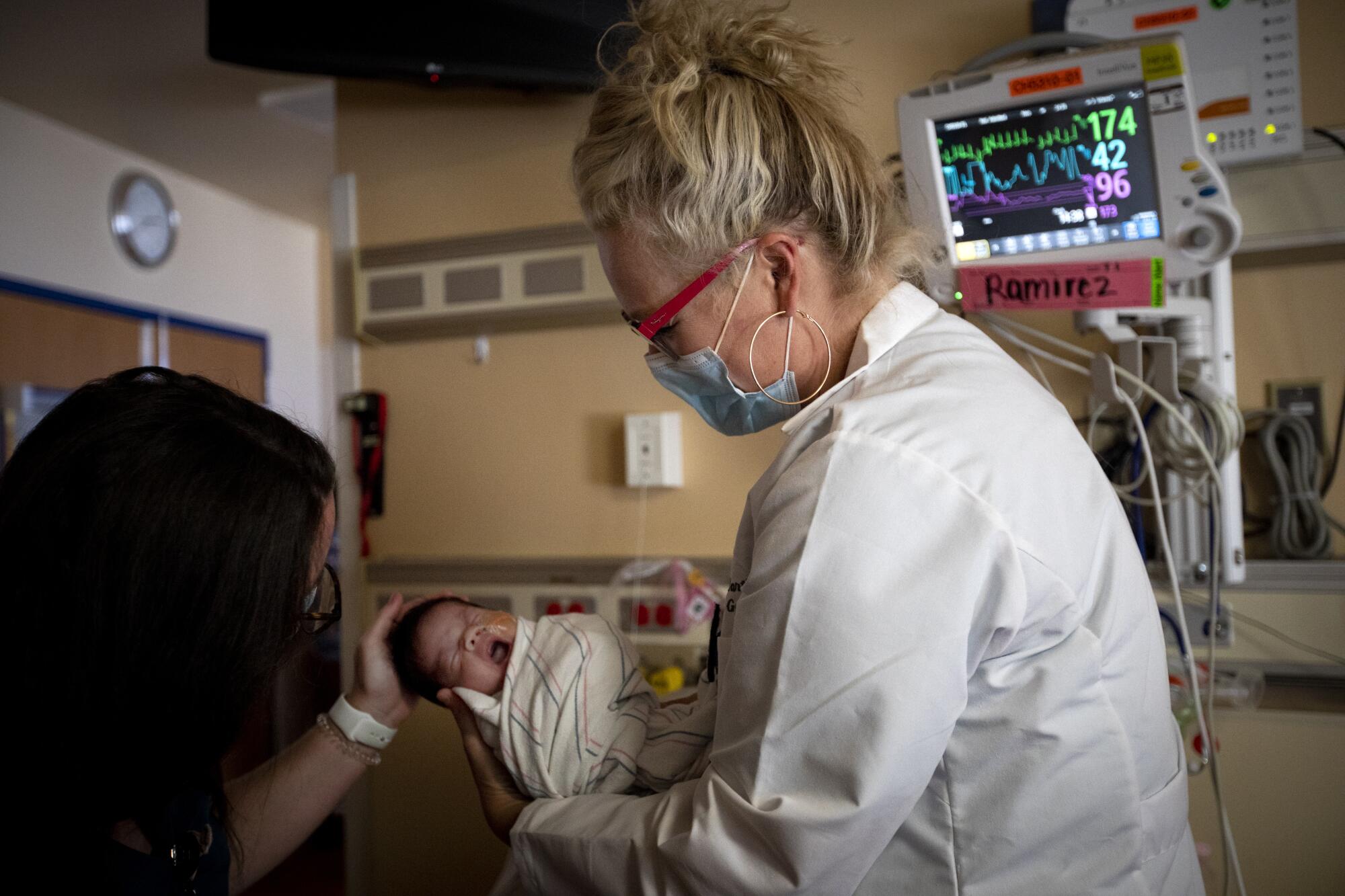
She wasn’t due for 10 weeks, but her amniotic sac, which protects the fetus from injury, had broken. The condition is called PPROM — preterm, premature rupture of membranes — and it is common among pregnant women who are very sick. Obstetricians have begun to see this condition in pregnant women with COVID-19.
“The body is saying, ‘Something is wrong. I’m mounting a stress response. I need to deliver the baby to make sure Mom can survive,’” Martin said. “On top of that … [Ramirez] needed more help breathing.”

The medical team tried to induce labor, but after 24 hours, Ramirez was no closer to giving birth. Even with the ventilator’s help, her breathing worsened. She needed more and more oxygen. Emiliana began to struggle. The only choice was surgery.
Martin was on call and delivered the tiny girl.
Ten fingers. Ten toes. A healthy first cry.
But in the ICU after the emergency caesarean section, Ramirez’s heart stopped beating. Twice.
Weeks later, she would talk about her “out-of-body experience” with more than a little awe. Her late father had had a liver transplant at Loma Linda 17 years earlier. On July 13, she said, “my dad was here with me.”
On that day, she said, “I died. I came back. I gave birth.”
::
Martin can’t explain why the pregnant COVID-19 patients admitted to the hospital have been so sick; more than a quarter of those women have needed some kind of help breathing, but only two required ventilators. And only two had to deliver their babies while in a medically induced coma.
Ramirez was the first. Blanca Rodriguez — age 32 and only 28 weeks pregnant — was the other.
The coronavirus has killed Latinos at a rate disproportionate to their share of the population. Doctors don’t exactly know why.
Rodriguez lives in Adelanto with her husband, a construction worker; her two sons, 6 and 8; her two teenage brothers-in-law; and another brother-in-law and his wife. In late July, she began to have trouble breathing.
“I felt,” she said, “like somebody was suffocating me.” It took four tests at the hospital before she received a positive result for the virus.
Her condition worsened. As Rodriguez was hooked up to a ventilator, both she and her baby went into serious distress. Martin ordered an emergency caesarean section. Rodriguez never made it to the operating room: Jade was delivered July 27 in the intensive care unit. She weighed 2 pounds, 11 ounces.
When Rodriguez awoke eight days later in the ICU, she saw the walls covered in baby pictures. She touched her stomach and asked the nurse about the images. “That’s when I found out that I had my baby.”

That’s when she found out all of the photographs were of Jade.
Researchers at UCLA and UC San Francisco have created a nationwide registry of 1,300 pregnant women with COVID-19 so they can follow their progress. The registry includes women who were infected in each trimester of pregnancy, allowing researchers to study how the disease affects fetuses at various stages of development. Ninety-five percent of the women in the study were not hospitalized.
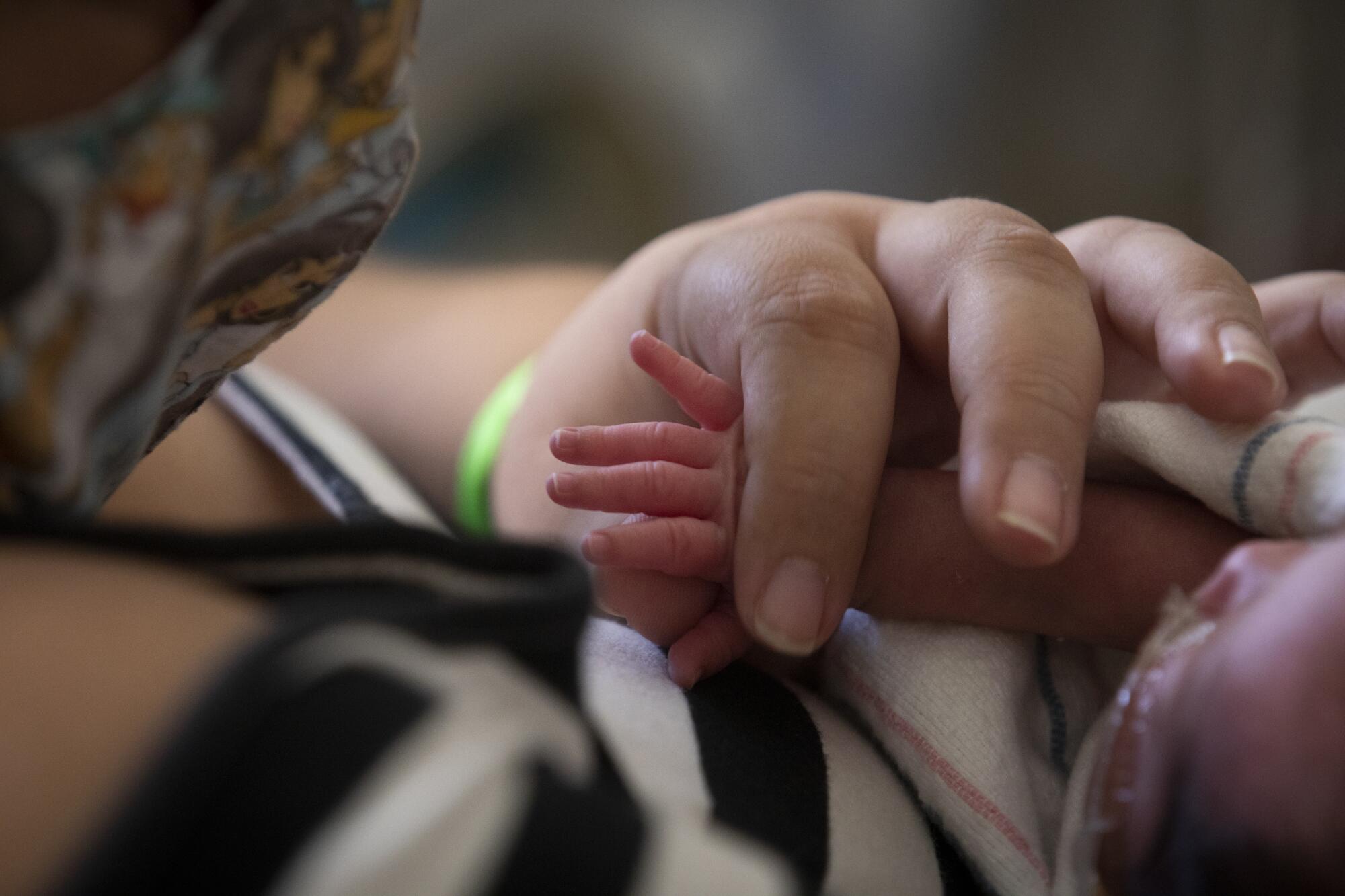
Among the study’s findings so far are that pregnant women tend to have different early symptoms than other COVID-19 patients: more cough and sore throat and less fever. Also, 25% of the women in the study still had symptoms after eight weeks.
One problem in caring for pregnant women with COVID-19, Martin said, is that they can look OK one moment and be really sick the next, with few warning signs that things will go from bad to worse.
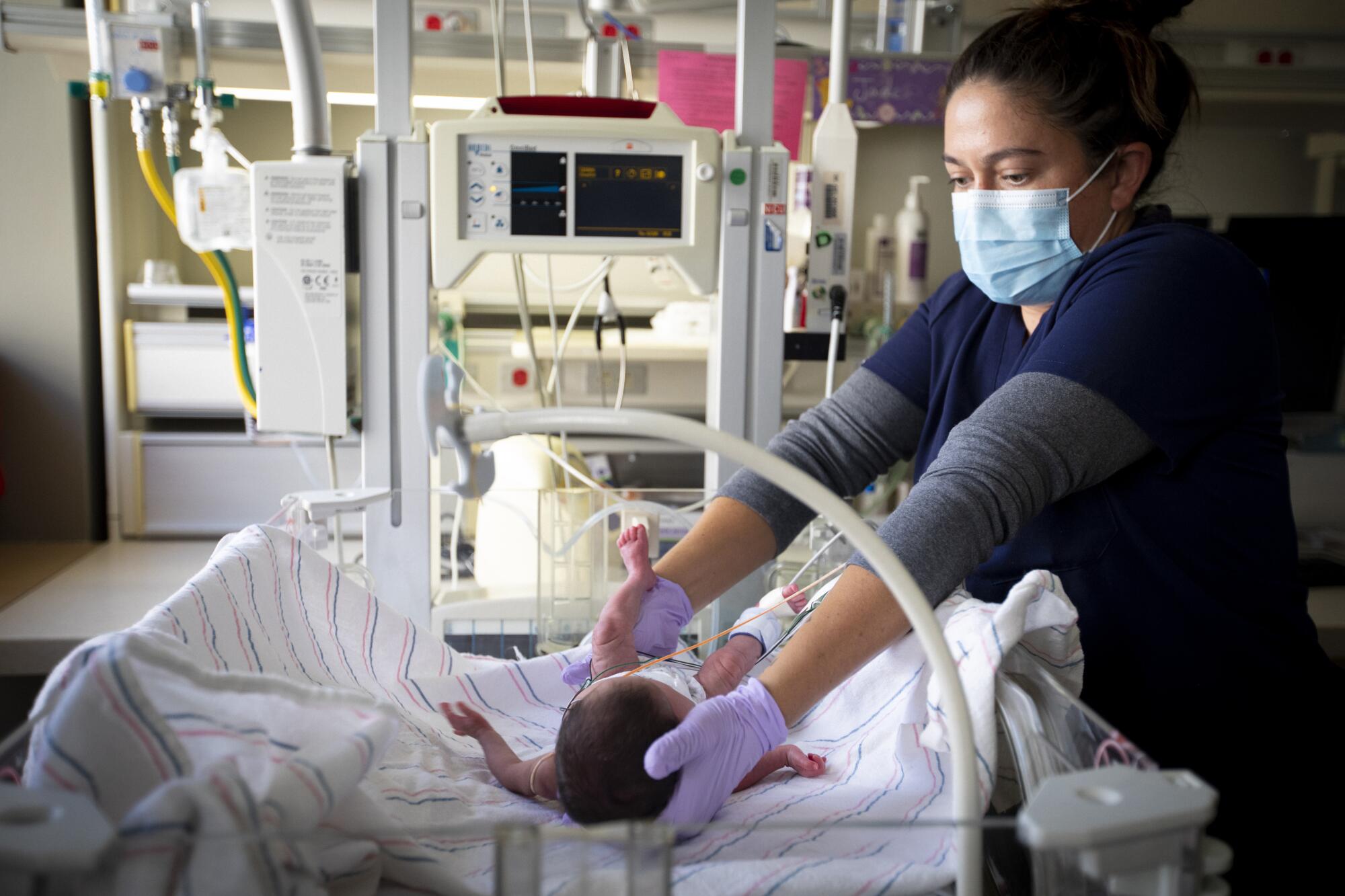
In emergency departments and ICUs, doctors use so-called “early warning scores” to predict the course of illness. The scores include such factors as age, gender, fever and CT scan findings; the higher the score, the more likely the patient will become very sick. Doctors tend to avoid ordering CT scans for pregnant patients because they want to limit the baby’s exposure to radiation. But that also lowers the early warning score.
Martin and her Loma Linda colleagues have used their data to fashion a diagnostic tool with pregnant women in mind. They’ve submitted their work to the medical journal Obstetrics & Gynecology and are waiting to hear whether it will be published.
“We wanted to build a system that is specific to pregnant women, because they present differently than non-pregnant COVID patients,” Martin said.
::
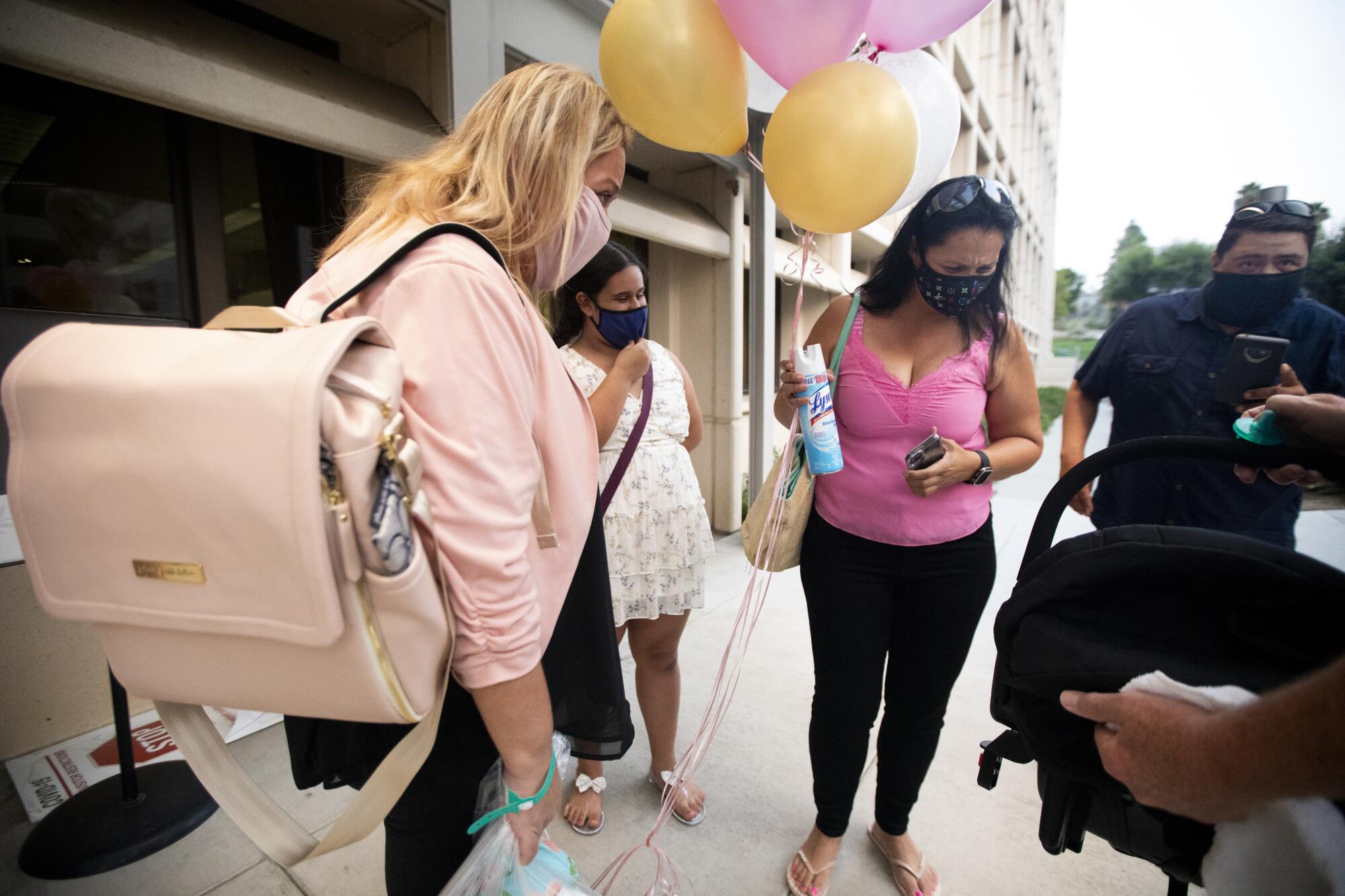
By Labor Day, Emiliana had doubled in weight. She was breathing on her own and eating from a bottle instead of the feeding tube that had snaked through her tiny nose and into her stomach for weeks. She’d graduated from preemie-size diapers to newborn, although they still swam on her slender frame. She was 56 days old and ready to go home.
Ramirez was ready, too. She pulled Emiliana’s travel clothes from her diaper bag and arrayed them on the rocking chair beside the baby’s bassinet: a sleeveless pink dress with a sequined bodice and a delicate net skirt. Tiny white socks with pink-and-white sequined bows on the arch. A headband with a white bow.
It had been a long two months. Three days after Ramirez could breathe on her own, she was discharged from Loma Linda and transported to a nursing home, the kind of place she’d vowed never to put someone she loved. She lasted six days there and signed herself out.
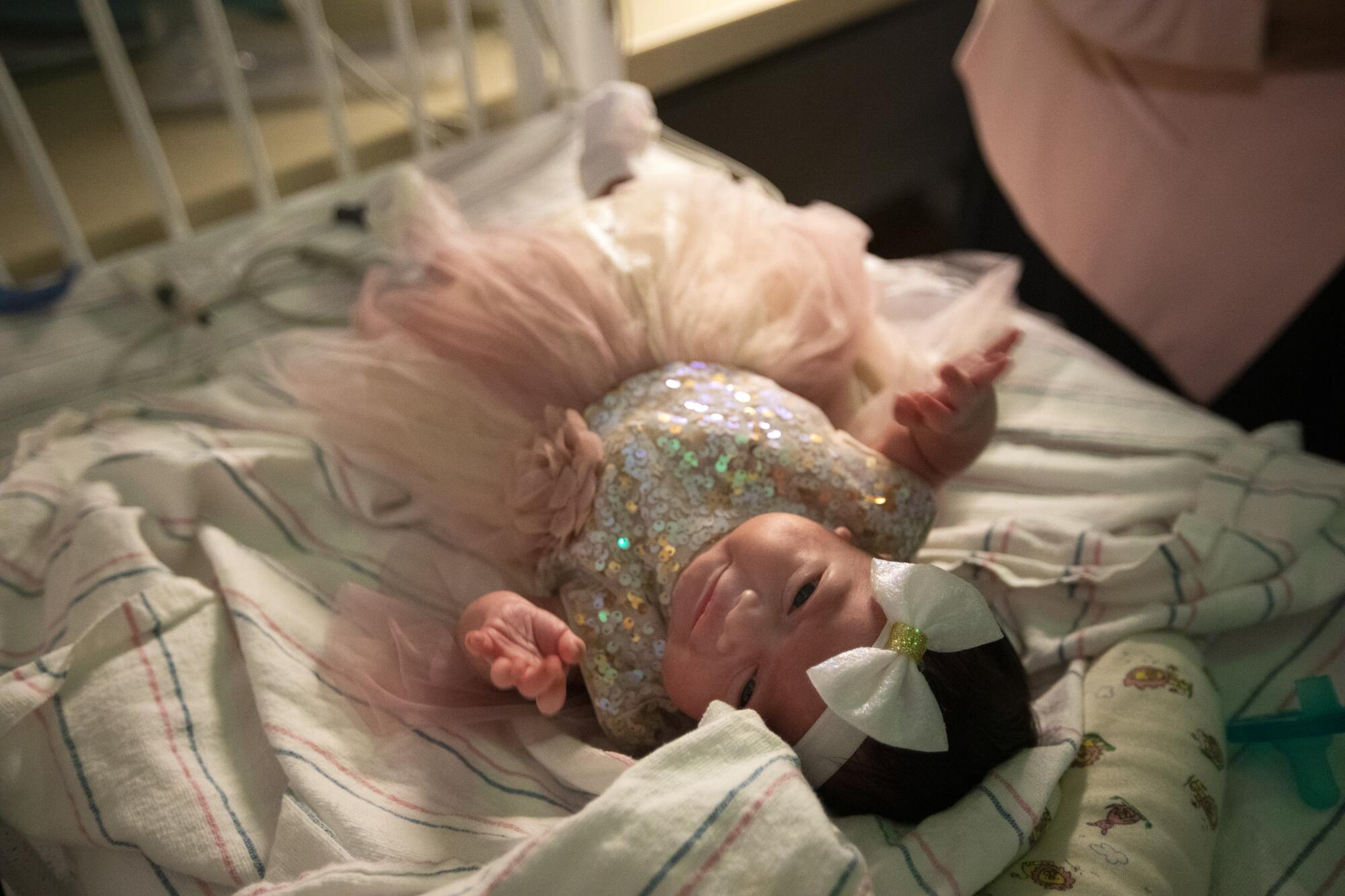
She had seen Emiliana for the first time Aug. 6 via Zoom. After two negative coronavirus tests, she was allowed to visit the NICU on Aug. 15 and hold her baby for the first time. She was exhausted after about 20 minutes.
“They got me a rocking chair and got me comfortable,” Ramirez said. “But I got really tired. I didn’t want to drop her. I said, ‘Can you just put her back? I want her to be safe.’”
But on this day, she zipped Emiliana into her fancy clothes. She got a final lesson on preemie care from a nurse named Doug: “The No. 1 reason for babies having fevers and showing up in the emergency room is over-dressing and blankets.”
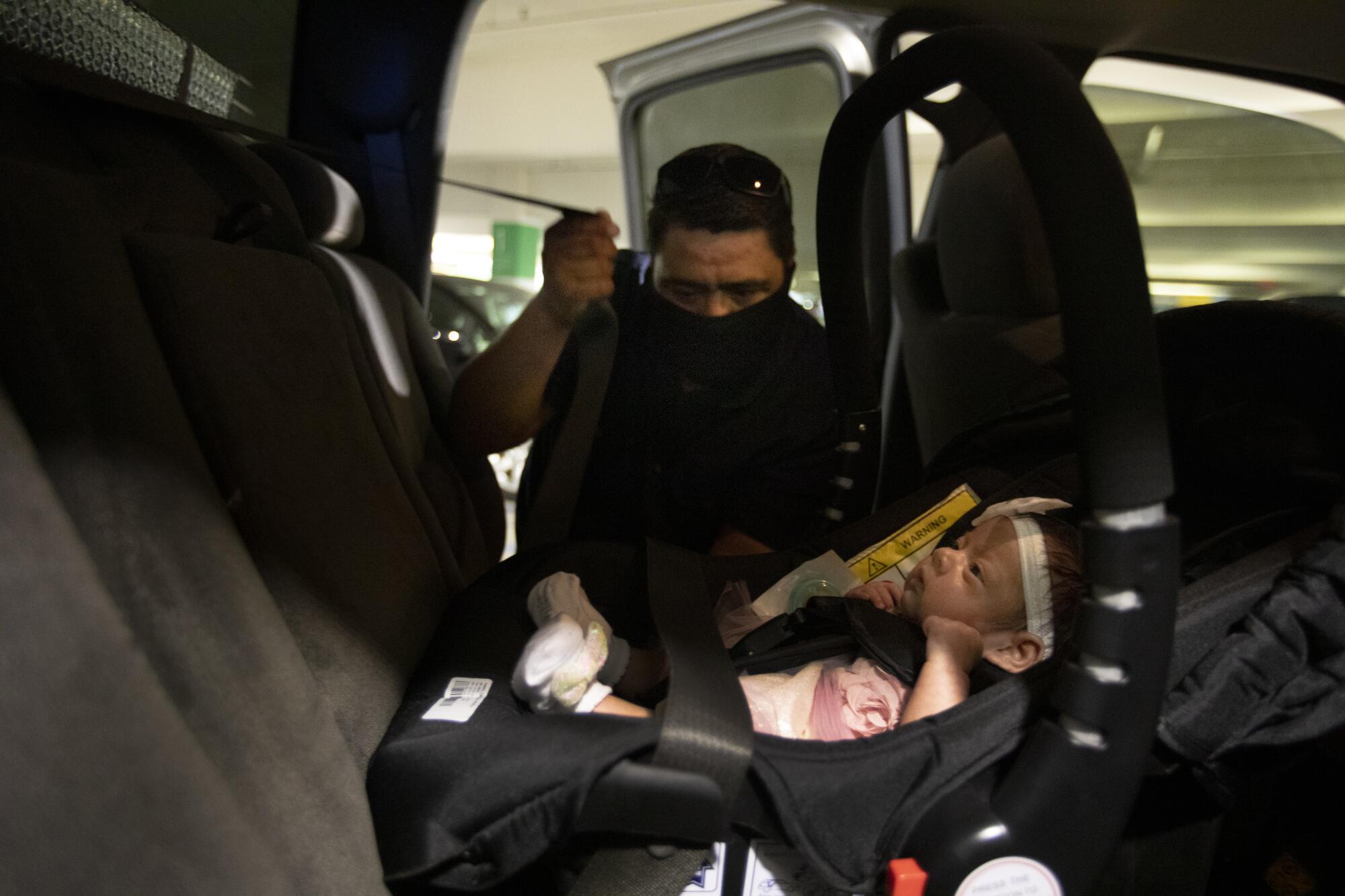
She strapped the baby into her car seat. Doug took the laminated sign — “Ramirez” — off the monitor that had flashed Emiliana’s vital signs and handed it to the anxious mom. He picked up the car seat. Ramirez grabbed her purse and diaper bag.
They walked out of the NICU and into the world.
Times staff photographer Francine Orr contributed to this report.
More to Read
Start your day right
Sign up for Essential California for news, features and recommendations from the L.A. Times and beyond in your inbox six days a week.
You may occasionally receive promotional content from the Los Angeles Times.

